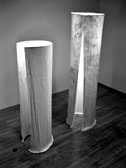|

Comment
on this story
Where:
UT's Ewing Gallery, the Art & Architecture Building, 1715 Volunteer Blvd. (call 974-3200 for hours)
When:
Through Nov. 11
|
|

Six Women Professors Present Their Artwork
by Heather Joyner
How a pile of soil can be erotic, amusing, and beautiful—all at the same time—is difficult to explain. It must be seen to be believed. As one in a number of pieces belonging to Displaced, a current Ewing Gallery exhibition featuring work by UT professor Jennifer Odem, this crusty little masterpiece is part of a show-within-a-show. Presenting art by five other women artists, Convergence provides the larger context. It is a gutsy collection of sculptural works (excepting Virginia Derryberry's paintings) created by individuals who, including Odem, appear to be at the height of their powers. Together, the two exhibitions remind us that serious, acknowledged art can be lighthearted, that one's materials can be trusted to inspire and lend meaning, that art by women need not refer to womanhood, that art is an exploration of life.
Regarding Convergence participants, Dr. Virginia Spivey of UNC Asheville has written, "Although each of these artists is distinct in visual approach, they converge in their fundamental belief that the artistic process yields resolution in aesthetic form....[they] have reached common ground, but where will they go next?" My question is this: Precisely what things are the above women seeking to resolve? Are we talking about refining material choices or understanding hard-to-define impulses? Does all this elaborate questioning amount to a steaming heap of art critical hooey? Personally, I like the work in the show because it does not come off as being too self-conscious or too self-righteous. It is confident yet generally unassuming—challenging, but fun.
Speaking of fun, Odem and USC professor Virginia Scotchie appear to be enjoying their respective processes quite a bit. Alongside Odem's untitled dirt pile (which she sprays with water on a daily basis to keep it from falling apart) are five other pieces comprising Displaced. In the entrance to the gallery, her pigmented plaster and resin "Umbra" has an arresting presence, resembling as it does a well-endowed udder that's been dusted with Dutch cocoa. As such, it's an appropriate introduction to apparently fertile ground within the Ewing's walls.
"Umbra" also signals a multiplicity of meaning found in most works presented; a multiplicity referred to by Odem when she says, "Seemingly delicate sculptures, made from strong, durable materials expose a gap that exists between the permanent and impermanent, the feminine and masculine, and the natural and artificial." However, Odem's contrast-produced tension is not always as rigid as it sounds. Her untitled marble dust mound with a zipper has a positively playful feel and Dada bent, and her osmocote-encrusted "Concrescent"—a towering yellow form with a long "snout" on top—is mildly obscene. Two resin and plaster "hanging curtain" installations could be considered somewhat austere (although one of them has odd, almost testicular "nodes" within—gold amidst the fleece, if you will).
In keeping with the aforementioned Dadaist spirit are Scotchie's memorable ceramic pieces. Crafted from clay, they automatically allude to functionality and timelessness. Yet Scotchie modifies familiar forms, allowing us to see her pieces as objects without specific purposes. At the same time, she avoids the multicolored and bulbous outer-space look of many contemporary pieces attempting objecthood and "lightness." What's Dadaesque about works like her "Yellow Bronze Float," reminiscent of a baby dinosaur's rattle, is their tongue-in-cheek humor and their refusal to grant sacred status to primitivism.
Von Allen, an art professor at Brigham Young University and the other ceramic artist included in Convergence, produces work concerned with mid-life issues. Her iconic, multi-fired body parts address feelings of vulnerability and impermanence. She says, "My artwork offers a visual record of my personal struggles for growth and understanding." Possibly more intriguing is how her interest in Carl Jung finds expression in immediately recognizable human forms with universal gestures.
Alison Helm of West Virginia University and Virginia Commonwealth University's Reni Gower flesh out the three-dimensional offerings. Gower's textiles-dominated installations are what she calls "visually complex....organized chaos," and Helm's multimedia constructions are similarly complicated. Whereas Gower's pieces tend to look alike and are thus a tad predictable, Helm's assemblages are lively, often with odd components. For instance, "Systems By Association" (a totemic stainless steel and glass piece with what appear to be Easter eggs on a kebob) adopts a [Dr.] Seussian Modernism and evokes artwork from many eras. But as fascinating as it is, it's a bit crowded. Both artists are accomplished, but they seem to avoid taking chances that could enhance their efforts.
Finally, we have the paintings of Virginia Derryberry (who like Spivey, teaches at UNC Asheville). Her always-masterful work is herein as striking as usual. But it doesn't fit the show. Beyond its contrasting two-dimensionality, it conveys no poetic whimsy whatsoever. Allen and Odem might allow themselves vulnerability, but it's nothing like this. Instead, Derryberry's images of burning forests and structures are about insignificance and overwhelming fear. Describing her new landscapes, she says, "Meditative views set next to the uncontrollable forces of conflagration and flooding reveal the futility of human intervention. The essential mystery and eternal, regenerative quality of nature remains." Despite the intense beauty of Derryberry's paintings, they ultimately leave us with a sense of powerlessness, not wonder—making them quite different from other pieces on view.
Together, Convergence and Displacement celebrate close-to-home talent and make for a gallery-going experience that should not be missed.

October 30, 2003 * Vol. 13, No. 44
© 2003 Metro Pulse
|